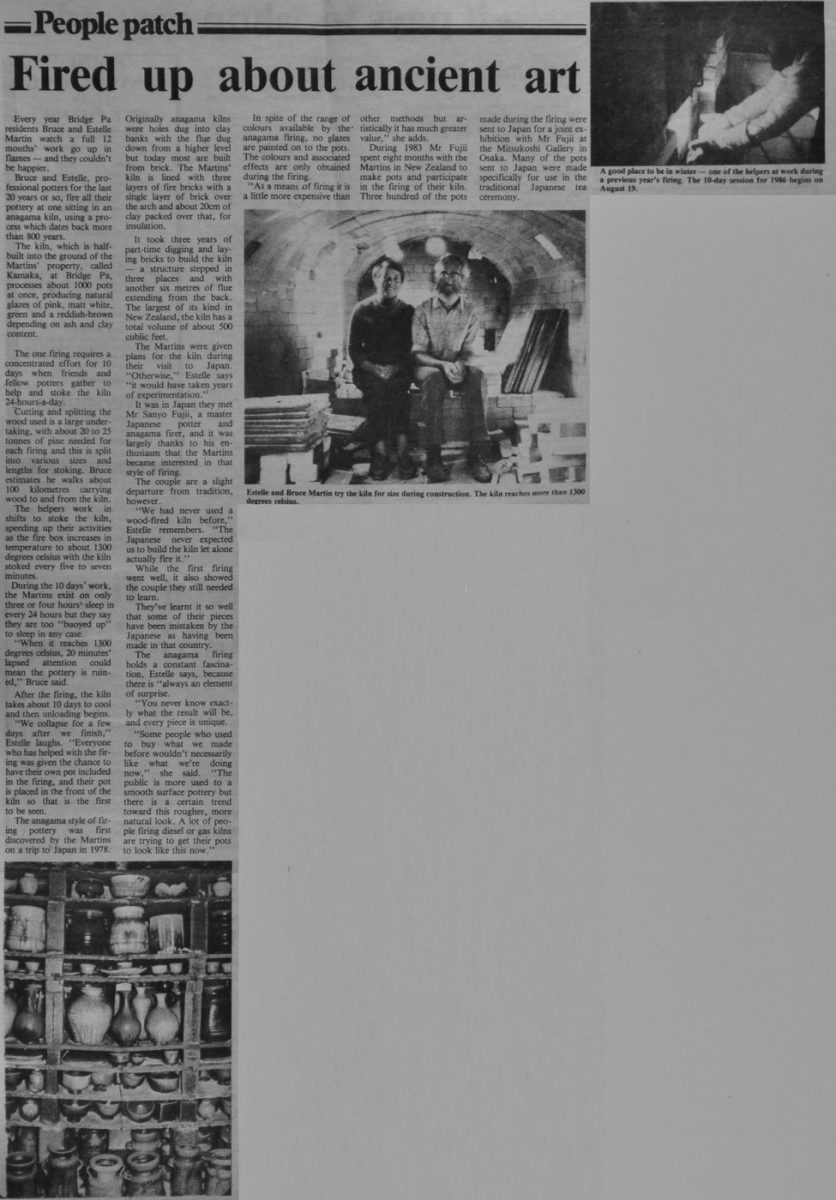People patch
Fired up about ancient art
Every year Bridge Pa residents Bruce and Estelle Martin watch a full 12 months’ work go up in flames – and they couldn’t be happier.
Bruce and Estelle, professional potters for the last 20 years or so, fire all their pottery at one sitting in an anagama kiln, using a process which dates back more than 800 years.
The kiln, which is half-built into the ground of the Martins’ property, called Kamaka, at Bridge Pa, processes about 1000 pots at once, producing natural glazes of pink, matt white, green and a reddish-brown depending on ash and clay content.
The one firing requires a concentrated effort for 10 days when friends and fellow potters gather to help and stoke the kiln 24-hours-a-day.
Cutting and splitting the wood used is a large under-taking, with about 20 to 25 tonnes of pine needed for each firing and this is split into various sizes and lengths for stoking. Bruce estimates he walks about 100 kilometres carrying wood to and from the kiln.
The helpers work in shifts to stoke the kiln, speeding up their activities as the fire box increases in temperature to about 1300 degrees celsius with the kiln stoked every five to seven minutes.
During the 10 days’ work, the Martins exist on only three or four hours’ sleep in every 24 hours but they say they are too “buoyed up” to sleep in any case.
“When it reaches 1300 degrees celsius, 20 minutes’ lapsed attention could mean the pottery is ruined,” Bruce said.
After the firing, the kiln takes about 10 days to cool and then unloading begins.
“We collapse for a few days after we finish,” Estelle laughs. ‘‘Everyone who has helped with the firing was given the chance to have their own pot included in the firing, and their pot is placed in the front of the kiln so that is the first to be seen.
The anagama style of firing pottery was first discovered by the Martins on a trip to Japan in 1978. Originally anagama kilns were holes dug into clay banks with the flue dug down from a higher level but today most are built from brick. The Martins’ kiln is lined with three layers of fire bricks with a single layer of brick over the arch and about 20cm of clay packed over that, for insulation.
It took three years of part-time digging and laying bricks to build the kiln – a structure stepped in three places and with another six metres of flue extending from the back. The largest of its kind in New Zealand, the kiln has a total volume of about 500 cublic [cubic] feet.
The Martins were given plans for the kiln during their visit to Japan. “Otherwise,’’ Estelle says “it would have taken years of experimentation.”
It was in Japan they met Mr Sanyo Fujii, a master Japanese potter and anagama firer, and it was largely thanks to his enthusiasm that the Martins became interested in that style of firing.
The couple are a slight departure from tradition, however.
“We had never used a wood-fired kiln before,” Estelle remembers. “The Japanese never expected us to build the kiln let alone actually fire it.”
While the first firing went well, it also showed the couple they still needed to learn.
They’ve learnt it so well that some of their pieces have been mistaken by the Japanese as having been made in that country.
The anagama firing holds a constant fascination, Estelle says, because there is ‘‘always an element of surprise.
“You never know exactly what the result will be, and every piece is unique.
“Some people who used to buy what we made before wouldn’t necessarily like what we’re doing now,” she said. “The public is more used to a smooth surface pottery but there is a certain trend toward this rougher, more natural look. A lot of people firing diesel or gas kilns are trying to get their pots to look like this now.”
In spite of the range of colours available by the anagama firing, no glazes are painted on to the pots. The colours and associated effects are only obtained during the firing.
“As a means of firing it is a little more expensive than other methods but artistically it has much greater value,” she adds.
During 1983 Mr Fujii spent eight months with the Martins in New Zealand to make pots and participate in the firing of their kiln. Three hundred of the pots made during the firing were sent to Japan for a joint exhibition with Mr Fujii at the Mitsukoshi Gallery in Osaka. Many of the pots sent to Japan were made specifically for use in the traditional Japanese tea ceremony.
Photo captions –
A good place to be in winter – one of the helpers at work during a previous year’s firing. The 10-day session for 1986 begins on August 19.
Estelle and Brian Martin try the kiln for size during construction. The kiln reaches more than 1300 degrees celsius.












Do you know something about this record?
Please note we cannot verify the accuracy of any information posted by the community.